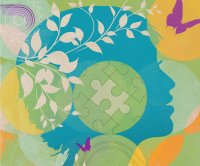Going Beyond ‘How Are You Feeling?’
When students have the language to describe their feelings and needs, they are better equipped to help themselves and each other.
Your content has been saved!
Go to My Saved Content.During the pandemic, there have been many uses of the term well-being. When teachers ask students only “How are you feeling?” as a way to gauge well-being, opportunities are missed to teach students that well-being is a multidimensional concept that encompasses more than just happiness. Research shows that if youth explicitly learn about well-being, their concept of subjective well-being can increase because they become mindfully aware of its components.
Present Dimensions of Well-Being
Help students understand two definitions for well-being: In the hedonistic tradition, students evaluate how satisfied they are with their lives, how pleasurable their lives are, and how happy they feel. In the eudaimonic tradition, they assess their personal strengths, areas of growth, and how they contribute to the greater good. This more expansive understanding of well-being can guide students to learn from challenging events and circumstances.
Introduce students to the following dimensions of well-being:
- Belonging and connection to others. Ask students, “Where do you feel like you most belong? Are you participating in a specific activity when you feel belonging? What do the people around you do to make you feel like you belong?” Also inquire about times they do not feel like they belong. What do they do to feel connected?
- Growth and flourishing. Ask students to describe a personal skill that they have grown in over the last two years. Describing how they have thrived can reinforce the understanding that well-being can involve challenges.
- Purpose. We often focus too much on what career path students may want to take, leaving youth feeling a lack of purpose when they don’t know those answers. Encourage students to identify short-term purposes, such as, “Today I am going to help my father cook dinner,” in addition to long-term goals.
- Engagement. Identifying engagement can be as simple as asking students, “What do you enjoy doing?” Students can explore ways they are engaged within their family, school, or community.
- Voice. Let youth know that there are many different ways to share their voice. Maybe they express themselves best through less traditional forms, such as writing equations, being in nature, participating in performing arts, or playing musical instruments.
- Basic supports for health and life. Remind students of their basic needs. Ask about what they do if their needs are not being met, and encourage them to name trusted adults they can turn to for help.
Engage with the Dimensions
Establish a space where well-being education will be welcomed by inquiring about student needs. Ask, “How would you like your peers to show that they support you when you are feeling down? How would you like me to support you?” Record the answers and discuss ideas until the group is in agreement. Model the process by sharing something that was difficult for you and asking for community support.
Offer ways the dimensions might show up in daily life. For example, “One dimension I feel is going well is belonging because my family is supporting one another right now.”
Sentence frames can help students make connections while using critical thinking to apply new terminology to lived experience, such as the following:
____________(insert dimension) means ____________ to me. It looks like and feels like ____________. In my daily life, an example of a positive ____________ (insert dimension) is ____________.
For example, a fifth grader used the dimension “basic supports for health and life” to write, “Basic support for health and life means that everybody can get to a doctor. It looks and feels like band-aids. In my daily life, an example of a positive basic support is that my grandma can get her medicine.”
An eighth grader used the dimension “voice” to write, “Voice means expressing my unique identity to me. It looks and feels like talking with my friends. In my daily life, an example of a positive voice is when my parents actually listen to me.”
Use the responses to gain new information about students and insight on ways they might need support.
Use Weekly Check-ins
Once a class has an understanding of the dimensions, they can be used to facilitate weekly check-ins. Check-ins can be incorporated into circle time, in advisory time, or via journals between the teacher and each child. Ask “What dimension of well-being has been challenging for you this week?” or “What dimension has been a strength for you this week?” Place paper with the dimensions on the floor, and have students walk to the dimension that has been a strength. Invite them to turn to their peers and discuss why they selected this dimension, using examples. Students report that this provides them with new examples of positive experiences that they can then consider in their own lives.
Avoid asking youth to elaborate upon challenges, as probing questions can lead to retraumatization. Instead, accept what students share and how they share. Validate their responses by listening intently, asking, “What support do you need from me?” When they identify needs, follow through in your support for them. Supporting student ideas, versus immediately working to project your ideas for solutions onto them, promotes youth agency.
Remind students that just because we are struggling in one dimension does not mean we are alone or that we have zero well-being. Counter the misconception that well-being is a “you’ve got it or you don’t” feeling.
When a student expresses something that has got them feeling down, discuss it. Then, when the time is right, ask, “I know that dimension ______ has been tough this week. Is there a dimension that has gone well?” When youth begin to see that one dimension could be positive while another dimension is negative, it reinforces the idea that well-being is multidimensional and not a fixed state.
